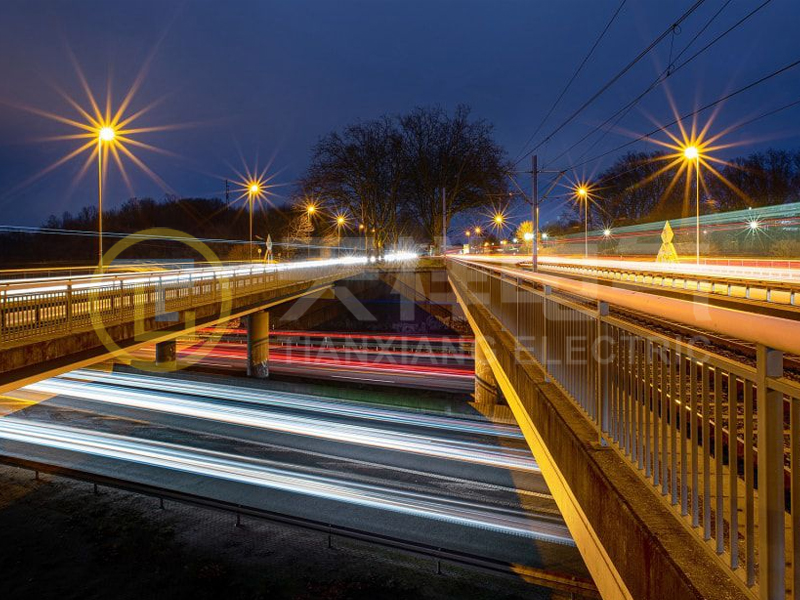Road lighting is an important aspect of urban planning and infrastructure development. It not only improves visibility for drivers and pedestrians, but also plays an important role in ensuring safety in public places. As cities grow and evolve, understanding road lighting parameters is critical for effective design and implementation. This article takes an in-depth look at the key parameters that define road lighting, ensuring that the needs of all road users are met.
1. Illumination Level
One of the main parameters of road lighting is the illuminance level, measured in lux. This refers to the amount of light falling on a surface. Different types of roads require different levels of illumination. For example, highways typically require higher illumination levels than residential streets. The Illuminating Engineering Society (IES) provides guidance specifying recommended illumination levels for different road types to ensure visibility is sufficient for safe navigation.
2. Uniformity
Uniformity is another key parameter in road lighting design. It measures the consistency of light distribution within a given area. High uniformity indicates an even distribution of light, reducing the chance of dark spots that can create safety hazards. Uniformity is calculated by dividing the minimum illuminance by the average illuminance. For road lighting, a ratio of 0.4 or higher is generally considered acceptable, ensuring that all areas are adequately illuminated.
3. Color Rendering Index (CRI)
The color rendering index (CRI) is a measure of how accurately a light source displays colors compared to natural light. For road lighting, a higher CRI is preferable because it allows drivers and pedestrians to more accurately perceive color, which is critical for identifying traffic signals, road signs, and other important visual cues. For road lighting applications, a CRI of 70 or above is generally recommended.
4. Light Source Type
The type of light source used in road lighting significantly affects energy efficiency, maintenance costs and overall performance. Common light sources include high pressure sodium (HPS), metal halide (MH), and light emitting diodes (LEDs).
- High Pressure Sodium (HPS): Known for their yellowish light, HPS lamps are energy efficient and have a long service life. However, their low color rendering index can make color identification difficult.
- Metal Halide (MH): These lamps provide whiter light and have a higher CRI, making them suitable for areas where color identification is critical. However, they consume more energy and have a shorter lifespan than high-pressure sodium lamps.
- Light Emitting Diode (LED): LEDs are becoming increasingly popular due to their energy efficiency, long lifespan, and ability to offer a wide range of color temperatures. They also allow for better control of light distribution, reducing light pollution and glare.
5. Pole Height and Spacing
The height and spacing of light poles are important parameters that affect the road lighting effect. Taller poles can illuminate a larger area, while shorter poles may require closer spacing to achieve the same level of coverage. The optimal height and spacing depends on the type of road, the light source used and the required illumination levels. Proper light pole placement minimizes shadows and ensures light reaches all areas of the roadway.
6. Glare Control
Glare is a significant issue in road lighting because it impairs visibility and creates hazardous driving conditions. Effective road lighting design includes measures to minimize glare, such as using screening devices or directing light downwards. The goal is to provide adequate lighting without causing discomfort to drivers or pedestrians. Glare control is particularly important in urban areas where streetlights are located close to residential buildings and businesses.
7. Energy Efficiency
With increasing concerns about energy consumption and environmental impact, energy efficiency has become a key parameter in road lighting design. Using energy-saving light sources such as LEDs can significantly reduce energy consumption and reduce operating costs. Additionally, incorporating smart lighting technologies, such as adaptive lighting systems that adjust brightness based on traffic conditions, can further improve energy efficiency.
8. Maintenance and Durability
Maintenance requirements and durability of road lighting fixtures are important considerations. Lighting systems should be designed to be easily accessible to facilitate maintenance and reduce downtime. Additionally, the materials used to manufacture lighting fixtures should be durable and weather-resistant to withstand environmental conditions. A regular maintenance schedule should be developed to ensure that lighting systems remain functional and effective over time.
9. Environmental Impact
Finally, the impact of road lighting on the environment cannot be ignored. Light pollution, which damages ecosystems and affects human health, is a growing concern in urban areas. Designing roadway lighting systems that minimize light spill and glare can help mitigate these effects. In addition, the use of energy-saving technologies helps reduce carbon emissions and is in line with sustainable development goals.
In conclusion
In summary, road lighting parameters cover a range of factors that affect safety, visibility and environmental impact. By considering illumination levels, uniformity ratios, light source type, pole height and spacing, glare control, energy efficiency, maintenance and environmental impacts, city planners and engineers can design effective roadway lighting systems that improve safety and quality of life on all roadways user. As technology continues to evolve, the future of road lighting is expected to be more efficient and sustainable, paving the way for safer and more vibrant urban environments.
Post time: Oct-31-2024





